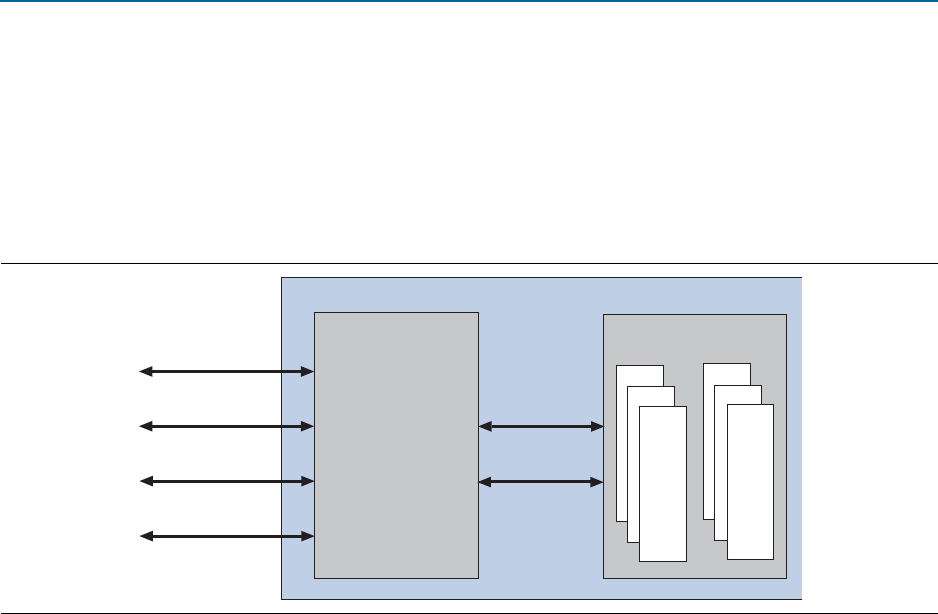User guide
Table Of Contents
- Cyclone V Hard IP for PCI Express User Guide
- Contents
- 1. Datasheet
- 2. Getting Started with the Cyclone V Hard IP for PCI Express
- 3. Getting Started with the Avalon-MM Cyclone Hard IP for PCI Express
- Running Qsys
- Customizing the Cyclone VHard IP for PCI Express IP Core
- Adding the Remaining Components to the Qsys System
- Completing the Connections in Qsys
- Specifying Clocks and Interrupts
- Specifying Exported Interfaces
- Specifying Address Assignments
- Simulating the Example Design
- Simulating the Single DWord Design
- Understanding Channel Placement Guidelines
- Adding Synopsis Design Constraints
- Creating a Quartus II Project
- Compiling the Design
- Programming a Device
- 4. Parameter Settings for the Cyclone V Hard IP for PCI Express
- 5. Parameter Settings for the Avalon-MM Cyclone V Hard IP for PCI Express
- 6. IP Core Architecture
- Key Interfaces
- Protocol Layers
- Multi-Function Support
- PCI Express Avalon-MM Bridge
- Avalon-MM Bridge TLPs
- Avalon-MM-to-PCI Express Write Requests
- Avalon-MM-to-PCI Express Upstream Read Requests
- PCI Express-to-Avalon-MM Read Completions
- PCI Express-to-Avalon-MM Downstream Write Requests
- PCI Express-to-Avalon-MM Downstream Read Requests
- Avalon-MM-to-PCI Express Read Completions
- PCI Express-to-Avalon-MM Address Translation for Endpoints
- Minimizing BAR Sizes and the PCIe Address Space
- Avalon-MM-to-PCI Express Address Translation Algorithm
- Single DWord Completer Endpoint
- 7. IP Core Interfaces
- Cyclone V Hard IP for PCI Express
- Avalon-MM Hard IP for PCI Express
- Physical Layer Interface Signals
- Test Signals
- 8. Register Descriptions
- Configuration Space Register Content
- Altera-Defined Vendor Specific Extended Capability (VSEC)
- PCI Express Avalon-MM Bridge Control Register Access Content
- Avalon-MM to PCI Express Interrupt Registers
- PCI Express Mailbox Registers
- Avalon-MM-to-PCI Express Address Translation Table
- Root Port TLP Data Registers
- Programming Model for Avalon-MM Root Port
- PCI Express to Avalon-MM Interrupt Status and Enable Registers for Root Ports
- PCI Express to Avalon-MM Interrupt Status and Enable Registers for Endpoints
- Avalon-MM Mailbox Registers
- Correspondence between Configuration Space Registers and the PCIe Spec 2.1
- 9. Reset and Clocks
- 10. Transaction Layer Protocol (TLP) Details
- 11. Interrupts
- Interrupts for Endpoints Using the Avalon-ST Application Interface
- Interrupts for Root Ports Using the Avalon-ST Interface to the Application Layer
- Interrupts for Endpoints Using the Avalon-MM Interface to the Application Layer
- Interrupts for End Points Using the Avalon-MM Interface with Multiple MSI/MSI-X Support
- 12. Optional Features
- 13. Flow Control
- 14. Error Handling
- 15. Transceiver PHY IP Reconfiguration
- 16. SDC Timing Constraints
- 17. Testbench and Design Example
- Endpoint Testbench
- Root Port Testbench
- Chaining DMA Design Examples
- Test Driver Module
- Root Port Design Example
- Root Port BFM
- BFM Procedures and Functions
- 18. Debugging
- A. Transaction Layer Packet (TLP) Header Formats
- Additional Information

Chapter 6: IP Core Architecture 6–3
Key Interfaces
December 2013 Altera Corporation Cyclone V Hard IP for PCI Express
User Guide
Key Interfaces
If you select the Cyclone V Hard IP for PCI Express, your design includes an
Avalon-ST interface to the Application Layer. If you select the Avalon-MM Cyclone V
Hard IP for PCI Express, your design includes an Avalon-MM interface to the
Application Layer. The following sections introduce the interfaces shown in
Figure 6–2.
.
Avalon-ST Interface
An Avalon-ST interface connects the Application Layer and the Transaction Layer.
This is a point-to-point, streaming interface designed for high throughput
applications. The Avalon-ST interface includes the RX and TX datapaths.
f For more information about the Avalon-ST interface, including timing diagrams, refer
to the Avalon Interface Specifications.
RX Datapath
The RX datapath transports data from the Transaction Layer to the Application
Layer’s Avalon-ST interface. Masking of non-posted requests is partially supported.
Refer to the description of the
rx_st_mask
signal for further information about
masking. For more information about the RX datapath, refer to “Avalon-ST RX
Interface” on page 7–5.
TX Datapath
The TX datapath transports data from the Application Layer's Avalon-ST interface to
the Transaction Layer. The Hard IP provides credit information to the Application
Layer for posted headers, posted data, non-posted headers, non-posted data,
completion headers and completion data.
The Application Layer may track credits consumed and use the credit limit
information to calculate the number of credits available. However, to enforce the PCI
Express Flow Control (FC) protocol, the Hard IP also checks the available credits
before sending a request to the link, and if the Application Layer violates the available
credits for a TLP it transmits, the Hard IP blocks that TLP and all future TLPs until
Figure 6–2.
PMAPCS
Hard IP for PCI Express
Altera FPGA
Avalon-ST
Interrupts
Clocks and Reset
LMI
PIPE Interface
Transceiver
Reconfiguration
PHY IP Core for
PCI Express (PIPE)










